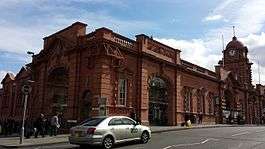Nottingham station
| Nottingham | |
|---|---|
|
Nottingham station main entrance after redevelopment | |
| Location | |
| Place | Nottingham |
| Local authority | City of Nottingham |
| Coordinates | 52°56′49″N 1°08′46″W / 52.947°N 1.146°WCoordinates: 52°56′49″N 1°08′46″W / 52.947°N 1.146°W |
| Grid reference | SK574392 |
| Operations | |
| Station code | NOT |
| Managed by | East Midlands Trains |
| Number of platforms | 7 |
| DfT category | B |
|
Live arrivals/departures, station information and onward connections from National Rail Enquiries | |
| Annual rail passenger usage* | |
| 2010/11 |
|
| 2011/12 |
|
| 2012/13 |
|
| 2013/14 |
|
| 2014/15 |
|
| History | |
| Original company | Midland Railway |
| Pre-grouping | Midland Railway |
| Post-grouping | London, Midland and Scottish Railway |
| 22 May 1848 | Opened as Nottingham |
| 16 January 1904 | New building opened |
| 25 September 1950 | Renamed Nottingham City |
| 18 June 1951 | Renamed Nottingham Midland |
| 5 May 1969 | Renamed Nottingham |
| 9 March 2004 | Station Street tram stop opened |
| 2011-2014 | Redeveloped |
| 27 July 2015 | Nottingham Station tram stop opened to replace Station Street |
| Listed status | |
| Listing grade | Grade II* listed |
| Entry number | Historic England listing reference 1271301 |
| Added to list | 12 July 1972 |
| National Rail – UK railway stations | |
| * Annual estimated passenger usage based on sales of tickets in stated financial year(s) which end or originate at Nottingham from Office of Rail and Road statistics. Methodology may vary year on year. | |
|
| |
Nottingham station, briefly known as Nottingham City and for rather longer as Nottingham Midland, is a railway station and tram stop in the city of Nottingham. It is the principal railway station of the city of Nottingham and the Greater Nottingham area. It is also a nodal point on the city's tram system, with a tram stop that was originally called Station Street but is now known as Nottingham Station.
The station was first built by the Midland Railway in 1848, and rebuilt by them in 1904, with much of the current building dating from that later date. It is now owned by Network Rail but managed by East Midlands Trains. Besides trains of that company, it is also served by CrossCountry and Northern trains, and by Nottingham Express Transit (NET) trams.
The station was one of several that once served the city. Amongst these were the city centre stations of Nottingham Victoria, on the Great Central Railway, and Nottingham London Road, on the Great Northern Railway, which are both now closed. A number of more minor stations served locations outside the city centre, but the only such station to remain open within the city boundaries is Bulwell.
History
Early beginnings
Nottingham's first station was Carrington Street station, which opened in May 1839, when the Midland Counties Railway opened the line from Nottingham to Derby. This terminus station was situated on the opposite side of Carrington Street to the current station, on a site now occupied by Nottingham Magistrates' Court. The original station gate posts still exist and form the pedestrian entrance to the Magistrates' Courts area.
The 1848 station
In 1844 the Midland Counties Railway merged with two others into the Midland Railway. By 1848, the new company had outgrown Carrington Street station and new lines to Lincoln had been opened. A new through station was opened on the current station site on 22 May 1848, replacing the Carrington Street station. The station was designed by the architect J E Hall of Nottingham, and had its entrance on Station Street. In 1869 the Midland Railway purchased the West Croft Canal arm, filling it and building additional parallel tracks to south.[1]
In the 1880s Nottingham station employed 170 men. Although attractive when it first opened, by the early 1900s the station was cramped, with only three platforms.
On 18 September 1896 a light engine, running tender first, was passing through the station when it came into collision with six empty fish trucks. One of the trucks was thrown off the rails against a cast-iron column supporting the inner ends of the principals of the station roof, and when the column broke, a portion of the roof, about 94 feet (29 m) by 56.5 feet (17.2 m) fell onto the platforms and track. Six people on the platform were injured.[2]
The 1904 station
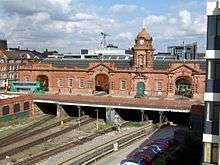
When the Great Central Railway opened its Victoria Station in 1900, the Midland Railway appointed Albert Edward Lambert,[3] a local Nottingham architect, to rebuild the Midland station. Lambert had been the architect for the Nottingham Victoria railway station and consequently the two buildings shared many similarities in their design. The station was re-built largely on the same site as the Station Street station, but the entrance was relocated onto Carrington Street.[4]
The first contract for the station buildings was awarded to Edward Wood and Sons of Derby on 23 January 1903, who were also awarded the contract for the buildings on platforms 1 and 2 on 16 September 1903. The contract for the buildings on platforms 4 and 5 was awarded to Kirk, Knight & Co of Sleaford on 18 June 1903, who were also responsible for building the parcels office (Forward House) on Station Street, which opened in November 1903. The structural steelwork and cast-ironwork was done by Handyside & Co.[5] and the Phoenix Foundry, both of Derby.
The station was built in an Edwardian Baroque Revival style at a cost of £1 million (£96.8 million in 2015),[6] and was described by the Evening News on the eve of its opening (16 January 1904) as a magnificent new block of buildings. The building used a mix of red brick, terracotta (which was used as a substitute for building stone) and faience (a glazed terracotta) with slate and glazed pitch roofs over the principal buildings. The carriage entrances have Art Nouveau wrought-iron gates.[7]
The station's forebuildings were opened to passengers without any formal ceremony on 17 January 1904, although next day the Evening News reported that the platforms were still in a state of chaos and these were not expected to be ready for another nine months. However it did consider that ‘the result promises to be the provision for Nottingham of one of the most commodious and most convenient passenger stations in the country’. The day began with the closure of the booking offices in the old station after the last tickets were issued for the 5:25 am London train and the new booking offices were opened in time to issue tickets for the 6:25 am Erewash Valley train. No attempt was made to exclude the public from the building and many took the opportunity to view the new station buildings. The Evening News commented on the public’s admiration of the style and elegance of the station approaches and booking hall and went on to describe the day’s events.[8]
The 20th century
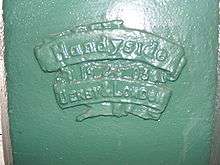
The station became the property of the London, Midland and Scottish Railway under the railway grouping of 1923, and was nationalised in 1948 by the Transport Act 1947, becoming part of British Railways. Following the privatisation of the railways in the 1990s, it was transferred to the ownership of Railtrack and subsequently Network Rail.
For many years the Midland Railway suffered the indignity of its rival, the Great Central Railway, crossing above the station on a 170-foot-long (52 m) bowstring girder bridge. This bridge became redundant in 1973 and was finally dismantled in the early 1980s. The alignment was later used for a new tramway bridge.[9]:8
Station Street tram stop
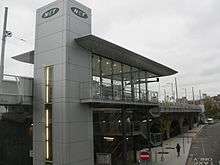
With the opening of the Nottingham Express Transit (NET) in March 2004, Nottingham station became the southern terminus of the new tram line. The actual tram stop was located on Station Street, directly north of Nottingham railway station and partially over the Nottingham Canal, and was constructed on a separate right-of-way, built on top of part of the old Great Central Main Line viaduct that used to lead northwards to the separate Nottingham Victoria railway station. To the north of the former stop, the tram route diverged from the old railway route, to join an on-street section through the centre of Nottingham. To the south the route ended at the end of the viaduct, where a since demolished bridge used to carry the Great Central line over the station. In 2012 work started to extend Nottingham Express Transit south towards Toton lane and Clifton South.[10]
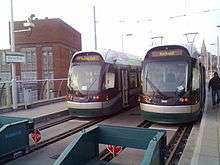
The tram stop itself was substantial, with a small station building containing a waiting area housing steps and a lift to reach the street below, plus as short footbridge over Station Street that connected to the main railway station. Up to three trams could be accommodated on the two platform faces: the western platform had a single length platform, while the eastern platform was an extended double-length platform.[10]
Redevelopment
Plans for a multimillion-pound refurbishment and redevelopment of the station were unveiled by junior government minister Norman Baker on 5 October 2010.[11][12][13] Under the scheme, the station's porte-cochère was to be made vehicle-free, and the station's Grade II* listed buildings restored. The redevelopment also included the construction of another platform, more shops, and the construction of a bridge to carry Nottingham Express Transit trams over the top of the station.[9]:5,8[14]
Funding
The redevelopment was initially estimated to cost £67 million.[15][16] East Midlands Development Agency stated they would contribute £9.5 million to the project, however had to reduce theis amount following government cuts.[12][17] In July 2009, the then Transport Minister, Sadiq Khan, gave conditional approval for the city council to use funds raised from their controversial "Workplace Parking Levy" to contribute to the redevelopment.[18]
The final funding was reorganised to be around £60 million: Network Rail contributing £41 million, Nottingham City Council £14.8 million, EMDA £2.1 million, East Midlands Trains £1.6 million, and the Rail Heritage Trust giving £0.5 million.[12][14]
Station masterplan
In 2001 the architects Building Design Partnership (BDP) were appointed as the lead consultants,[19]:3[20][21][22] using the same team which had redeveloped Manchester Piccadilly based on an estimate of £550,000[19]:4 and in cooperation with Posford Rail, MVA, Jones Lang LaSalle and Bovis Lend Lease.[22]
- Stage 1 of the Nottingham Station Masterplan cost £99,960[23] and was launched at Loxley House on 19 July 2002.[24]:4 The main stakeholders at the time were Nottingham City Council, Nottinghamshire County Council, Central Trains, Midland Mainline, Nottingham Development Enterprise, Nottingham Regeneration Limited and the EMDA which together acted as the Nottingham Railway Station Steering Group.[24]:1–2
- State 2a of the masterplan preparation was budgeted to cost £59,940.63 and also to be undertaken by BDP.[24]:5
BDP engaged Tuffin Ferraby Taylor to undertake surveys of all elements of the station dating from before 1918.[3] As well as an integrated NET tram station above platform 6,[9]:5 the masterplan included an additional concourse,[25] and safeguarding for an additional platform.[9]:5
Car park
Between 2011 and 2012, a new multi-storey car park (MSCP) was constructed between Platform 6 and Queen's Road, over the western half of the station's existing car park.[26] It was built by Vinci Construction.,[14] with work beginning in March 2011, and the car park was officially opened on 14 May 2012.[27]
The initial car park design had been put on hold during 2008 after being described as a "chicken coop".[28][29] The final design for the car park has 2,107 coloured metal sheets on the outside, formed of 2.1-millimetre-thick copper and stainless steel (1.5 mm stainless, 0.6 mm "Luvata" Copper).[29][30] These panels are fixed to the MSCP using 8000 cleats fixed to pre-cast channels in the concrete structure.[30] The new car park building has five storeys[31] and was designed to have space for 950 cars.[32]
Remodelling
Schemes costing £19 million (in 2007) and then £14 million (in 2008) were proposed.[33]:1 Remodelling and re-signalling costing £11.6 million was approved on 15 May 2009 by the Network Rail Investment Board,[34] and will take place as part of Control Period 4 (CP4) running from 1 April 2009 to 31 March 2014.[35] Nottingham station will be partially closed for ten weeks during 2013 for the track and signalling work.[36] During the blockade, the western end of the station will be closed to trains for 37 days and the eastern end for 10 days.[37]
Platform 4 has been split to create two platforms.[38][39] All four tracks at the western end will have bi-directional railway signalling allowing a better choice of non-conflicting routes.[38] These lines will be referred to as Line A, Line B, Line C and Line D.[40]:61 Although all lines will be directional, their intended use will be segregated, with services towards Sheffield and Mansfield focused on the northern pair of tracks, and services to Derby and Leicester focused on the southern pair of tracks.[35][41]:140 Line-speeds for trains arriving from Chesterfield and the Robin Hood Line will be increased from 35 miles per hour (56 km/h) to 50 miles per hour (80 km/h).[38] On 7 March 2012 Network Rail requested formal "network change" acceptance from the train operating companies.[41][42]
| Platform number | previous | 1 | 2 | 3 | 4 | 5 | 6 | |
|---|---|---|---|---|---|---|---|---|
| Platform length | | | |
| | | ||
| Platform number | post-2013 | 1 | 2 | 3 | 4 | 5 | 6 | 7 |
| Platform length | | | | | | | ||
On-site preparation works began in September 2011, with all new signal structures installed by June 2013 followed by the "Nottingham blockade" itself lasting from July 2013, until handover in September 2013.[41]:141 The work is spread from Beeston, past Mansfield Junction, Nottingham West Junction and to Nottingham East Junction.[41]:140 The blockade is designed to cover renewing 5.9 kilometres (3.7 mi) of track and adding or renewing 14 sets of pointwork.[41]:140
Footbridge
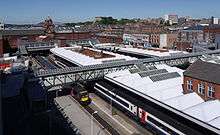
Halfway along the platforms is an overhead footbridge running from Station Street (at the north) and the tram stop link, over station platforms 1–5 to platform 6 and car parking facilities at Queen's Road (at the south).[9]:2 The footbridge carries Footpath 28, the only traffic-free crossing over the Midland Main Line in Nottingham.[43]:4 Footpath 28 was previously diverted from the demolished footbridge 21 to the present footbridge 20B during the 1990s. The original route formed part of the "Trent Bridge Footway"[43]:4 carrying the public between the centre of Nottingham and the river crossing at Trent Bridge. In 2004 Nottingham City Council stated that right of way over the footbridge would be closed following the completion of a multi-storey car park.[9]:4
Alternative pavement improvement works were scheduled for Queens Road in February 2009.[33]:2 During 2008–2012 BPR Architects submitted designs for automated ticket gate (ATG) barrier installations at St Pancras, Sheffield, Derby, Nottingham station concourse plus both ends of Nottingham footbridge 20B.[44]:2[45] BPR's design included four ATG barriers on the north end of the footbridge itself plus a new enclosure and four barriers between the car park and platform 6 at the south end.[46][47] A procedure to permanently stop-up the right-of-way commenced on 19 March 2010,[43]:1 A planning application for barriers was filed on 29 March 2010 and withdrawn again on 10 May 2010.[48] Following a public inquiry held during 8–9 November 2011, the stopping up order was denied; the inspector summing up:[43]:8[49][50]
Footpath 28 is unique and offers an experience which the alternative, replacement, route cannot – a traffic free route within the city which in addition provides a convenient link for a large number of users to and from residential areas, work places and other facilities. It provides a short but valued opportunity for pedestrians to get away from trafficked routes, with the added amenity value of an historic environment. On balancing the merits and demerits of the stopping up order, I find that the disadvantages and loss likely to arise as a result of the stopping up of the footpath to members of the public generally are such that permanent closure of Footpath 28 to the public is not justified. Thus I conclude that the Order should not be confirmed.— Susan Doran BA Hons MIPROW, Inspector appointed by the Secretary of State for Environment, Food and Rural Affairs, Decision Notice §44, 13 December 2011[43]:8
New bridge and tram stop
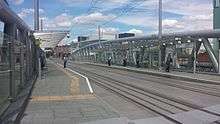
In order to facilitate the Nottingham Express Transit's phase two extension into the south of the city, it was planned to have the tram line cross the station on the line of the original Great Central Railway viaduct that had been closed to passenger trains in 1967 and goods in 1973. This would involve a bridge, crossing from the existing Station Street stop, which would close, over both the station and Queen's Road. A replacement tram stop would be sited on the bridge.[9]:5,8[51][52]
Construction of the tram bridge started on 10 April 2012, and the bridge was jacked into place in May 2013. The tram bridge design is a Warren truss design made of 508-to-711-millimetre (20 to 28 in) diameter steel tubes.[53]:6 The main bridge is 14.530 metres (48 ft) wide between the truss centrelines, with two equal spans of 52.120 metres (171 ft). The bridge is officially called the Karlsruhe Friendship Bridge, after Nottingham's twin city of Karlsruhe in Germany.[53]:6[54][55][56]
The new Nottingham Station tram stop was constructed on the bridge, so as to provide interchange with the railway network. It replaced the previous Station Street tram stop, opened in 2004, which was located approximately 100 metres (330 ft) to the north. The new Nottingham Station stop was opened on 27 July 2015 and the previous stop closed at the same time, although the intention is to reopen the Station Street access building as a second access to the new stop once it has been refurbished. The new stop served as the new southern terminus of the system until the rest of NET's phase two opened, at which point it became a through station with trams continuing to new termini in Chilwell and Clifton.[10][57][57][58]
Layout and facilities
Layout
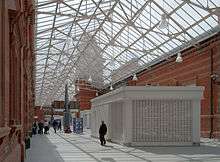
The station is aligned approximately east to west, at the southern edge of the city centre, with Station Street to the north and Queen's Road to the south. At the western end of the station, the tracks are spanned by Carrington Street, and the station's main entrance is on the eastern side of this street. Since the completion of the station redevelopment, the entrances from Carrington Street open into a concourse that spans the station from north to south. This occupies what was once the station's porte-cochère, and provides a large pedestian circulation area, along with several retail sites.[9]:3–5[59]
The ticket hall for the railway station opens off the centre of eastern side of the concourse, and in turn gives access via ticket barriers to a pedestrian overbridge with stairs and lifts down to the railway platforms. A second concourse opens off the main concourse at the southern end of its eastern side, and this runs parallel and to the south of the platforms, giving access by stairs, lifts and escalators to the tram stop, the station car park, taxi rank, vehicular pick-up and drop-off points and Queen Street. The tram stop spans the station from north to south to the east of the main entrance, at a higher level than the concourse, and to the east of that a second footbridge links the platforms and carries the previously referred to footpath 28.[9]:3–5[59]
The station's multi-storey car park lies to the south of the platforms, to the north of Queen Street, and to the east of the tram bridge. It provides parking for around 800 cars, and the covered area below it houses the station's new taxi rank and pick-up and drop-off points, relocated from the old porte-cochère.[9]:3–5[59]
Railway platforms
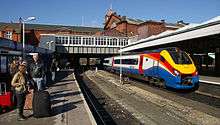
The railway platforms lie at a lower level than the station entrance, and are within a ticket barrier enforced paid area. From north to south the station has two island platforms and a single side platform, with a total of seven numbered platform faces.[60] Each platform is linked to both the main entrance concourse by stairs and lifts, and by stairs only to the second footbridge.[59]
The northern of the two island platforms has a bi-directionally signalled through platform face on each side, numbered respectively 1 and 3, together with an east facing bay, numbered 2. The two through platforms are long enough to accommodate fifteen and fourteen coach trains respectively, whilst the bay can accommodate a four coach train.[60]
The middle island platform also has bi-directionally signalled through platform faces on each side, numbered 4 and 6, together with a west-facing terminal platform face numbered 5. Platform 4 can accommodate a five coach train, platform 5 a seven coach train, and platform 6 a fourteen coach train.[60]
Finally the southern side platform is numbered 7, and can accommodate a thirteen coach train. Sufficient space exists to the south of this platform to add a second platform face, effectively converting this side platform into an island platform, if traffic increases to justify it.[9]:7[60]
Tram stop
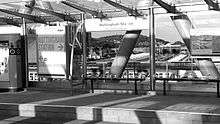
The new tram stop lies at a higher level than the station entrance, and at 90 degrees to railway platforms. It is designed as a through stop, with two side platforms flanking each side of the double track. Like all other NET stops, pedestrian access between the platforms is permitted on the level via crossings at each end of the platforms. Ticket machines are located on both platforms, and the stop lies outside the ticket barrier enforced paid area of the railway station.[57]
The stop is connected directly to the railway station's main concourse, and thus the railway platforms, by the new side concourse, with stairs, escalators and lifts to bridge the height difference. A direct access is also provided to the station car park. The former access from Station Street has closed for refurbishment, but will reopen as a further entrance to the new stop, accessing it by a walkway parallel to the tracks.[57]
To the north of the stop, the tracks pass over Station Street and through the abandoned platforms of the former Station Street stop, before proceeding along the old Great Central Main Line viaduct and eventually joining an on-street section through the centre of Nottingham. To the south of the new stop, the tracks pass over Queen Street before descending a ramp to ground level and rejoining the city's streets. The junction between the Clifton and Chilwell branches lies just beyond this point.[61]
Operation
National Rail services
Current off-peak services from the station include:
- 1tph to London St Pancras (fast) via East Midlands Parkway, Leicester and Market Harborough (East Midlands Trains)
- 1tph to London St Pancras (slow) via Loughborough, Leicester, Kettering, Wellingborough, Bedford and Luton Airport Parkway (East Midlands Trains)[62]
- 1tph to Liverpool Lime Street via Sheffield, Manchester Piccadilly and Warrington Central (East Midlands Trains)[63]
- 1tph to Norwich via Grantham, Peterborough and Ely (East Midlands Trains)
- 2tph to Mansfield Woodhouse, with 1tph continuing to Worksop (East Midlands Trains)[64]
- 1tph to Skegness via Boston (East Midlands Trains)[65]
- 1tph to Leicester via Loughborough (East Midlands Trains)
- 1tph to Lincoln via Newark Castle (East Midlands Trains)[66]
- 1tph to Matlock via Derby (East Midlands Trains)[67]
- 2tph to Birmingham New Street via Derby with 1tph continuing to Cardiff Central via Newport (CrossCountry)[68]
- 1tph to Leeds via Sheffield (Northern)[69]
| Preceding station | Following station | |||
|---|---|---|---|---|
| CrossCountry | Terminus | |||
| CrossCountry | ||||
| CrossCountry | ||||
| East Midlands Trains | Terminus | |||
| East Midlands Trains | Terminus | |||
| East Midlands Trains | ||||
Limited Service |
||||
Limited Service | East Midlands Trains | |||
| Terminus | ||||
Limited Service | East Midlands Trains Nottingham-Norwich | Terminus | ||
| Terminus | East Midlands Trains Nottingham-Skegness | |||
| East Midlands Trains | Terminus | |||
| East Midlands Trains | Terminus | |||
| Terminus | Northern Nottingham-Leeds | |||
Limited Service |
Nottingham Express Transit services
With the opening of NET's phase two, Nottingham station is now on the common section of the NET, where line 1, between Hucknall and Chilwell, and line 2, between Phoenix Park and Clifton, operate together. Trams on each line run at frequencies that vary between 4 and 8 trams per hour, depending on the day and time of day, combining to provide up to 16 trams per hour on the common section.[61]
| Preceding station | Nottingham Express Transit | Following station | ||
|---|---|---|---|---|
| Meadows Way West towards Toton Lane |
Line 1 | Lace Market towards Hucknall or Phoenix Park | ||
| Queens Walk towards Clifton South |
Line 2 |
See also
- Nottingham Victoria railway station (1890 to 1967)
- Nottingham Carrington Street railway station (1839 to 1848)
- Carrington railway station (1899 to 1928)
References
- ↑ Development Control Committee (23 April 2008). Historic Development and Archaeology. Station Conservation Area Character Appraisal and Management Plan (Report). Nottingham City Council. p. 8. Archived from the original on 3 September 2015. Retrieved 28 May 2012.
- ↑ "The Accident at Nottingham Station". London Evening Standard. British Newspaper Archive. 14 October 1896. Retrieved 27 July 2016 – via British Newspaper Archive. (subscription required (help)).
- 1 2 Tuffin Ferraby Taylor (2 April 2008). Johnstone, Rachael, ed. "Nottingham Railway Station" (PDF). Featured Projects. Retrieved 27 May 2012.
AE Lambert built the station between 1903 and 1904 for Midland Railway Company.
- ↑ The Railway Gazette Volume 37. University of Chicago: Queen Anne's Chambers. 1922. p. 743.
- ↑ Jill Armitage (11 August 2014). Derby: A History. Amberley Publishing. ISBN 1445634775.
- ↑ UK CPI inflation numbers based on data available from Gregory Clark (2016), "The Annual RPI and Average Earnings for Britain, 1209 to Present (New Series)" MeasuringWorth.
- ↑ "New Midland Station Nottingham". Nottingham Evening Post. England. 16 January 1904. Retrieved 1 March 2016 – via British Newspaper Archive. (subscription required (help)).
- ↑ "Opening of the New Nottingham Midland Station". Nottingham Evening Post. England. 18 January 1904. Retrieved 1 March 2016 – via British Newspaper Archive. (subscription required (help)).
- 1 2 3 4 5 6 7 8 9 10 11 Wood, Richard, ed. (27 July 2004). "Brief Description of Station Site". Nottingham Station Development Brief. Nottingham City Council. Archived from the original on 10 March 2013. Retrieved 27 May 2012.
- 1 2 3 "Station Street tram stop". The Trams.co.uk. Archived from the original on 26 August 2015. Retrieved 5 August 2015.
- ↑ Cook, Ben (5 October 2010). "Nottingham unveils station revamp plans". Regeneration & Renewal. Haymarket. Retrieved 28 May 2012.
- 1 2 3 "Transport Minister announces go-ahead for £60m station revamp". Nottingham Evening Post. 4 October 2010. Retrieved 28 May 2012.
- ↑ Nottingham City Council (4 October 2010). "Norman Baker, Under-Secretary of State for Transport, announces redevelopment of Nottingham station" (video). YouTube. Retrieved 28 May 2012.
- 1 2 3 Morby, Aaron (11 August 2011). "Vinci in talks to build £60m Nottingham station". Construction Enquirer. Retrieved 28 May 2012.
- ↑ "Nottingham Station".
- ↑ "Nottingham Station" (PDF). Transport by BDP. Building Design Partnership. 1 May 2012. p. 20. Retrieved 27 May 2012.
- ↑ Robinson, Jon (18 January 2010). "Fly through £67m station revamp deal is 'close'". Nottingham Evening post.
- ↑ "Nottingham tram extension funding approved". Railway Gazette. 31 July 2009. Retrieved 28 May 2012.
Nottingham City Council (31 July 2009). "NET Phase Two & Workplace Parking Levy go ahead" (video). YouTube. Retrieved 28 May 2012. - 1 2 Horne, Barry; Regeneration and Renewal Panel (11 October 2004). Wood, Richard, ed. Nottingham Station Master Plan. Report of the Duty Chief Executive (Report). Nottingham City Council. Retrieved 27 May 2012.
- ↑ Lumley, Keith, ed. (9 August 2010). "Station Transformation Moves a Step Closer". Press Releases. Network Rail. Retrieved 27 May 2012.
BDP … the Manchester studio has been involved in the redevelopment of Nottingham and Chester stations
- ↑ "BDP Appointed for Retail Element of Birmingham's New Street Station". News. Building Design Partnership. 15 February 2008. Retrieved 27 May 2012.
- 1 2 "Building Design Partnership – Nottingham Rail Station". Property Mall. 17 October 2001. Retrieved 27 May 2012.
- ↑ Jones, Adrian, ed. (14 February 2002). "Nottingham Station Masterplan". Report of the Director of Development and Environmental Services. Nottingham City Council. Retrieved 27 May 2012.
- 1 2 3 Planning and Transportation Policy Development and Review Committee (12 September 2002). Wood, Richard, ed. Nottingham Station Masterplan. Report of the Director of Development and Environmental Services (Report). Nottingham City Council. Retrieved 27 May 2012.
- ↑ Langston, Christopher (2 March 2009). "The path to Crossrail". Railway Strategies. Schofield Publishing (242). Retrieved 27 May 2012.
- ↑ Samuel, A. (7 March 2011). "Improvements at Nottingham station begin". Rail.co. Retrieved 27 May 2012.
- ↑ "Train station car park opens". Nottingham Evening Post. 15 May 2012. Retrieved 27 May 2012.
- ↑ "Station car park plan put on hold". BBC News Online. 20 August 2008. Retrieved 28 May 2012.
- 1 2 "Station car park plan moves ahead". BBC News Online. 19 December 2008. Retrieved 28 May 2012.
- 1 2 Specialist Cladding Systems (26 April 2012). "All Change as Contemporary Car Park Façade Transforms Nottingham Station". Retrieved 27 May 2012.
- ↑ "Train station car park opens". Nottingham Evening Post. 15 May 2012. Retrieved 28 May 2012.
- ↑ "Work starts on new Nottingham Railway Station car park". BBC News Online. 4 March 2011. Retrieved 28 May 2012.
- 1 2 Joint Officer Steering Group (24 October 2008). Bamford, Jim; Carter, Chris, eds. Rail Issues Update (PDF). Joint Committee on Strategic Planning & Transport (Report). Nottingham City Council; Nottingham County Council. Retrieved 29 May 2012.
- ↑ Joint Officer Steering Group (17 July 2009). Bamford, Jim; Carter, Chris, eds. "Nottingham station resignalling scheme enhancements". Joint Committee on Strategic Planning & Transport. Nottingham City Council; Nottingham County Council. Retrieved 28 May 2012.
- 1 2 "A New Start for Rail Passengers and Freight in the East Midlands". Press Releases. Network Rail.
Signalling renewals at Nottingham station … segregation of trains at the west end of Nottingham with bi-directionally paired tracks for trains to Derby / Leicester and Mansfield / Sheffield
- ↑ "Some of Passenger Focus's recent successes". Making a difference for all passengers. Passenger Focus. 13 February 2012. Retrieved 28 May 2012.
- ↑ Dangerfield, Guy (9 November 2011). Hewitson, Mike, ed. Service disruption caused by engineering work (PDF). Board Meeting Paper (Report). Passenger Focus. pp. 1–2. Retrieved 28 May 2012.
- 1 2 3 "Designs approved for 'biggest city rail upgrade in over 100 years'". Nottingham Evening Post. 18 July 2009. Retrieved 28 May 2012.
- ↑ "Go-ahead for £60m Nottingham railway station revamp". BBC News Online. 4 October 2010. Retrieved 27 May 2012.
- 1 2 Operational Planning Project Manager (13 April 2012). "East Midlands" (PDF). Timetable Planning Rules. Network Rail. p. 61,77. Retrieved 27 May 2012.
- 1 2 3 4 5 Programme – Nottingham resignalling (PDF). Network Rail CP4 Delivery Plan 2010 Enhancements programme: statement of scope, outputs and milestones (Report). Network Rail. 29 June 2010. pp. 140–141. Retrieved 28 May 2012.
- ↑ "Proposed G1 Network Change: Nottingham Station Area Signalling Renewals – Amendment" (letter). Network Rail. 7 March 2012. Retrieved 28 May 2012.
"NC G1 2010 LNE 012A Nottingham Station Area Signalling Renewal – Amendment" (directory). Network Rail. 28 May 2012. - 1 2 3 4 5 Doran, Susan (13 December 2011). Order Decision (PDF). Nottingham City Council (Nottingham Midland Station Footpath No.28) Stopping Up Order 2010 SUO 5015 (Report). The Planning Inspectorate.
"City of Nottingham Council". Online Rights of Way C. The Planning Inspectorate. 13 December 2011. Retrieved 28 May 2012. - ↑ BPR Architects. "Document Issues Sheet" (Schedule). East Midlands ATG Enabling Works (EMT). p. 2.
- ↑ "Fare-dodge crackdown at train station". Nottingham Evening Post. 26 January 2009. Retrieved 27 May 2012.
- ↑ "10/00885/LLIS1". 10 May 2010. Retrieved 26 May 2012.
Installation of automatic ticket gates on footbridge and erection of entrance enclosure to house automatic ticket gates to south of footbridge with associated CCTV cameras.
- ↑ NWW (24 February 2010). PBP, ed. "Proposed Entrance Enclosure General Arrangement" (drawing). Nottingham City Council. drawing 0847-01/53. Retrieved 27 May 2012.
- ↑ "Withdrawal of Planning Proposal" (PDF). Listed Building Consent.
Installation of automatic ticket gates on footbridge and erection of entrance enclosure to house automatic ticket gates to south of footbridge with associated CCTV cameras. … In accordance with your request, I am treating the above application as withdrawn.
- ↑ "Ramblers jubilant over saved station path" (press release). Press release archive. The Ramblers. 15 December 2011. Retrieved 28 May 2012.
- ↑ "Historic footpath saved by walkers". Nottingham Evening Post. 16 December 2011. Retrieved 28 May 2012.
- ↑ Clark, Paul (7 January 2007). Kay, Anthony, ed. "NET Forward" (PDF). Railwatch. Railfuture. p. 16.
exactly on the same alignment as the old Great Central Bridge closed in the early 1970s!
- ↑ Barker, Robert M; Novitzky, Alan (15 August 2008). "The Routes – Common Section". Report to the Secretary of State for Transport and the Secretary of State for Communities and Local Government. The Nottingham Express Transit System Order Application for Deemed Planning Permission Applications for Listed Building and Conservation Area Constent (Report). The Planning Inspectorate. p. 14. Archived from the original on 13 April 2014.
route would pass over the railway station on new viaduct, on the line of the former Great Central Railway
- 1 2 Duguid, Brian (15 March 2010). "Nottingham Station Bridge, UK" (PDF). Venice: Mott MacDonald. Archived from the original (PDF) on 15 April 2014. Retrieved 27 May 2012.
- ↑ Samuel, A. (10 May 2012). "New Nottingham tram design unveiled". Rail.co. Archived from the original on 23 November 2012. Retrieved 28 May 2012.
- ↑ "Extending NET over Nottingham Station". NET Phase Two. Nottingham City Council. 10 April 2012. Retrieved 27 May 2012.
- ↑ "Nottingham tram bridge 'inched' into position". BBC. 17 May 2013. Archived from the original on 8 June 2013. Retrieved 6 August 2015.
- 1 2 3 4 "New tram stop for station". Nottingham Express Transit. Archived from the original on 21 September 2015. Retrieved 5 August 2015.
- ↑ "Nottingham Express Transit Phase 2 opens". Railway Gazette. DVV Media UK Ltd. 25 August 2015. Archived from the original on 10 September 2015. Retrieved 25 August 2015.
- 1 2 3 4 "Nottingham Station Plan". National Rail Enquiries. Train Information Services Limited. Retrieved 3 September 2015.
- 1 2 3 4 Yonge, John; Padgett, David; Szwenk, John (August 2013) [1990]. Bridge, Mike, ed. Railway Track Diagrams 4: Midlands & North West (3rd ed.). Bradford on Avon: Trackmaps. map 6A. ISBN 978-0-9549866-7-4.
- 1 2 "Extending your Tram Service" (PDF). Nottingham Express Transit. Archived (PDF) from the original on 7 August 2015. Retrieved 18 August 2015.
- ↑ GB eNRT May 2016 Edition, Table 53
- ↑ GB eNRT May 2016 Edition, Table 49
- ↑ GB eNRT May 2016 Edition, Table 55
- ↑ GB eNRT May 2016 Edition, Table 19
- ↑ GB eNRT May 2016 Edition, Table 27
- ↑ GB eNRT May 2016 Edition, Table 56
- ↑ GB eNRT May 2016 Edition, Table 57
- ↑ GB eNRT May 2016 Edition, Table 34
External links
| Wikimedia Commons has media related to Nottingham railway station. |
